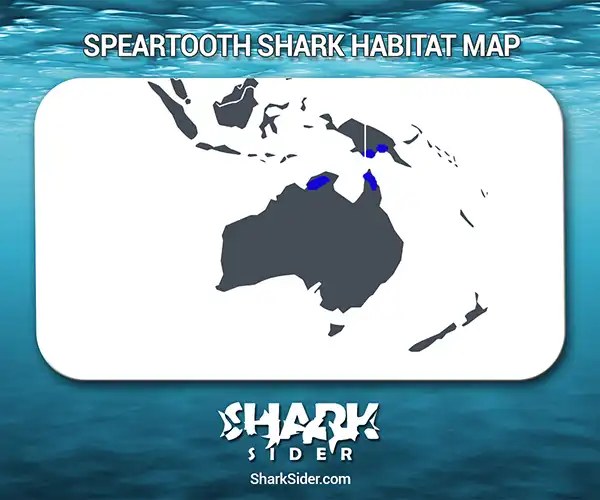Speartooth sharks are a species of requiem shark found in freshwater habitats. However, it seems to adapt well to saline habitats as well as it has been seen in both rivers and near-shore oceanic waters.
Little remains known about this shark, with most of the information about them coming from three captured adult specimens in 2014 – two males and one female.
Speartooth Shark Scientific Classification |
|
| Kingdom | Animalia |
| Phylum | Chordata |
| Class | Chondrichthyes |
| Order | Carcharhiniformes |
| Family | Carcharhinidae |
| Genus | Glyphis |
| Scientific Name | G. glyphis |
Description
Based on a few adults documented in 2014, the shark is assumed to be 8.5 ft long. They have a streamlined body with a broad head and a flat snout. Their eyes are small, and there are 26–29 upper and 27–29 lower tooth rows inside the shark’s mouth. The upper teeth are triangular and serrated, while those on the lower jaw are more spear-like and narrower, with the serrations limited to the top of the teeth.
This shark has large pectoral fins, triangular pelvic fins, two dorsal fins, with the second being 67-77% of the size of the first, an anal fin around the exact size of the second dorsal fin, and a misshapen caudal fin. There are oval-shaped dermal denticles all over this shark’s body. There are oval-shaped dermal denticles all over this shark’s body.
These sharks are plate gray from above and white ventrally, with a visible boundary separating the two areas.
Where do they live
Map Of The Speartooth Shark’s Habitat

Speartooth sharks range from New Guinea to northern Australia. It lives close to Daru Island, Fly River, and Port Romilly in New Guinea. The shark has a much broader distribution in Australia, including Bizant, Ducie, and Wenlock Rivers in Queensland and the Adelaide and Alligator Rivers in the Northern Territory. Reports indicate this shark lives in the Normanby, Hey, Ord, and Embly Rivers as well as the South Chinese Sea. However, whether or not they were speartooth sharks remains to be verified.
These sharks live primarily in freshwater habitats, like large, mangrove-lined tropical rivers and estuaries. The juveniles and sub-adults live close to the muddy bottoms of these habitats, where fast tidal currents are observed. However, the salinity levels of these waters, which range from fresh (0.8 ppt) to almost marine (28 ppt), indicate that these sharks can also survive in saltwater habitats.
Behavior
Hunting
Their diet includes ariid catfish, breams, burrowing gobies, croakers, gudgeons, prawns, and threadfins based on the activities of the juveniles. The adults are assumed to feed on bony fish and stingrays based on the spines and stings found in the captured specimens’ jaws.
Swimming
Their movements are sluggish, moving upstream with the flooding tide and downstream with the ebbing tide. They can travel around 6.2–7.5 miles like this.
Reproductive
Like other requiem sharks, they are viviparous, giving live birth from October to December. Initially, these sharks are 20–23 in long, with an annual growth rate of 7.5 in.
Adaptations
Their teeth are well suited for feeding on bony fish, while they seem to hunt using their ampullae of Lorenzini to detect the electrical fields generated by their prey.
They seem to maneuver in fast currents with the help of their second dorsal fin.
Interactions with humans
Due to its extreme rarity these sharks almost never come into contact with humans and are not considered a threat. As a river shark, the population is quite sparse with an estimated 2500 specimens globally and 250 in isolated areas.
This leaves this shark extremely vulnerable to fishing activities – both bycatch from commercial fishing and for sport by recreational anglers. Captured speartooths are sometimes eaten, used as bait, or just discarded. Habitat degradation, such as the pollution of the Fly River due to mining activities, has also caused a sharp decline in the shark’s population.
All these factors have caused the IUCN to classify this shark as “Vulnerable” or “VU”. It is classified as endangered in Australia under the Commonwealth Environment Protection and Biodiversity Conservation Act established in 1999 and the 2000 Territory Parks and Wildlife Conservation Act.
